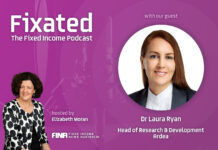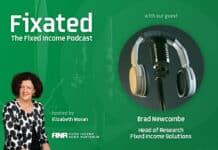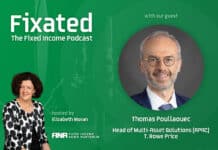
-
Signs of a confidence shock
-
Rate volatility is back
-
Where are the safe-havens?
The market symptoms of a confidence shock. It is rather uncommon to see a triangular market correction, namely that the treasury bond market, the equity market and finally the currency market of a given country would all sell off at the same time. But it does happen on occasions. Historically, this unusual market phenomenon had mainly been observed in emerging markets, when some episodical financial crises, be it in Brazil or in Turkey for instance, broke out back in the 1990s or 2000s. This is not purely an EM phenomenon, however. We all probably remember the UK mini financial crisis episode of October 2022. At the time, investors had lost confidence in the ability of the government to run the country’s financial affairs in a credible way, which led to a swift and un-ceremonial resignation of the prime minister. Fast forward a couple of years, and we are now observing signs that global investor confidence towards USD-denominated assets has been meaningfully dented. The USD is down, UST bond prices are down, and the US equity market is down. What do all these market events, in EM or in DM, have in common? To put it bluntly: a policy credibility shock. Policy credibility does matter and no country is above this basic market law. Not even the US, it seems. The most concerning signal appears to come from the UST market, in our view. While the somewhat deteriorating macro fundamentals should in principle have pushed bond yields lower, it is the opposite that is currently happening. Why? Perhaps because the UST market may have lost—at least temporarily—some of its legendary defensive characteristics. In the face of higher risk aversion, UST do not seem to offer currently the protection that they used to, hence leading to an upward pressure on yields. To be clear, it is still too early to tell if this confidence shock is going to persist for a long time. Given the extreme level of policy uncertainty, we believe the market backdrop can radically change in relatively short order. But for now, this unusual market regime entails some major implications. For a start, the correlation between bonds and equity seems to be rising again, which, if sustained, is going to undermine the role of fixed income as a portfolio diversifier. Meanwhile, US market rates are rising but for the wrong reasons. Nothing to do with an improved macro environment and all to do with the repricing of sovereign risk. On the currency market front, something unusual is also going on. The interest rate differential between the US and Europe has gone up substantially, a development that traditionally would trigger a strongly bullish signal for the USD, but currency markets no longer care about interest rate dynamics. The EUR is up, the USD is down. Finally, in our view there seems to be some global asset allocation shifts happening, with global investors looking at diversifying away from the US and looking at Europe and the Rest of the World as a more attractive place to invest. Overall, the market backdrop is quite challenging these days, which reinforces the case for active management. It seems that caution towards risky assets is warranted in the near term, given this US triangular correction risk and what it means.
Also read: A Tariff-ic Time For Bonds
MOVING the wrong way. Market volatility has clearly made a big comeback. This is particularly true for the equity market but that has not spared rate volatility either. The MOVE index is now back to about 138, its highest level since October 2023. This is an important development for fixed income. Indeed, the higher the rate volatility, the lower the conviction on duration. In other words, we believe duration is unlikely to be a major driver of total return if this elevated rate volatility environment persists in the period ahead. Some prudence is warranted when it comes to the rate view given the significant uncertainty. There are many opposing forces. In the category of market pressures that should push rates down, we find the downside risks to growth in the face of the potential tariff shock as well as higher expectations for future Fed rate cuts. Meanwhile, the resurfacing of inflation risks, and upward in inflation expectations, and poor UST market technicals are all pushing in the opposite direction. Overall, we believe that, at this juncture, fixed income managers that heavily rely on duration in order to generate excess returns are likely to face significant challenges in the period ahead. Given the rate volatility landscape, we think that in contrast, alpha that will arise from security selection is likely to be relatively less unpredictable.
Safe Havens Can’t Wait. It is fair to say that global markets have been quite turbulent since the so-called “Liberation Day”. The risk appetite picture changes quickly in the face of elevated volatility. So which global assets played the role of safe havens during the recent market turbulence? As underscored above, definitely not the US Treasury market, whose index lost 1.52% since April 1st.[i] The Bund index, in comparison, did much better, with a EUR-denominated gain of 1.34% during the same period—and considerably more in USD terms. [ii] Given current market dynamics, we believe the outperformers in global fixed income are likely going to be found in the asset classes that display low duration and low credit risks, together with low correlation with the US. With that in mind, the Global Agg index was the best safe haven, with a positive return of 0.83%.[iii] EUR IG also displayed strong resilience, with just marginally negative return (-0.20%).[iv] Meanwhile, it is also worth pointing that EM local debt performed strongly during that period, helped by the weaker dollar. The EM local debt index produced a return of 0.72%.[v] Away from fixed income, some currencies strongly benefitted from the broad dollar weakness. The Swiss franc has risen almost 8% since April 1st, reaffirming its status as a defensive asset. Gold gained about 3.5% during this time. Looking ahead, we need to see strong signals that tariff relief will be put in place or evidence that the US government is shifting its policy focus to growth-supporting measures before the risk backdrop will recover in a sustainable way.
[i] Source: Bloomberg. Bloomberg UST index. Returns are gross and in USD. Data as of 11 April 2025.
[ii] Source: Bloomberg. Bloomberg Bund index. Returns are gross and in EUR. Data as of 11 April 2025.
[iii] Source: Bloomberg. Bloomberg Global Agg index. Returns are gross and in USD. Data as of 11 April 2025.
[iv] Source: Bloomberg. Bloomberg pan-European IG credit index. Returns are gross and in EUR. Data as of 11 April 2025.
[v] Source: Bloomberg, JP Morgan. JP Morgan GBI-EM Diversified index. Returns are gross and in USD. Data as of 11 April 2025.

































